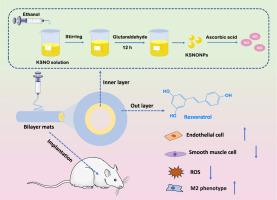Bilayer vascular grafts incorporated with S-nitrosated keratin nanoparticles and resveratrol to enhance long-term nitric oxide release and endothelialization
IF 9.6
1区 医学
Q1 ENGINEERING, BIOMEDICAL
引用次数: 0
Abstract
Intimal hyperplasia, thrombosis formation, and vascular calcification are the leading causes of failure in small-diameter vascular grafts. In the study, bilayer vascular grafts with separately released nitric oxide (NO) and resveratrol (RESV) were fabricated. S-nitrosated keratin nanoparticles (KNPs) were synthesized and subsequently electrospun with poly(ε-caprolactone) (PCL) to prolong the NO release for up to 25 d in the presence of ascorbic acid and trypsin, serving as the inner layer of grafts. Additionally, RESV was incorporated into poly(L-lactide-co-ε-caprolactone) (PLCL) fibers to alleviate oxidative stress and inflammation, acting as the outer layer of the grafts. The PCL/KNPs//PLCL/RESV bilayer grafts were capable of promoting endothelial cell proliferation while inhibiting the excessive proliferation of smooth muscle cells. Notably, bilayer grafts could regulate macrophage polarization toward the M2 phenotype. In rat abdominal aorta replacement models, the grafts retained patency for 3 months. These grafts could accelerate endothelialization without apparent intimal hyperplasia, thrombosis, inflammation, and calcification. These bilayer grafts are promising for small-diameter tissue-engineered vascular grafts.
Statement of significance
• S-nitrosated keratin nanoparticles (KNPs) were synthesized and subsequently electrospun to prolong the NO release for 25 d • Resveratrol (RESV) was incorporated into PLCL fibers to alleviate oxidative stress and inflammation. • Bilayer grafts promoted EC proliferation while inhibiting SMC proliferation. • Bilayer grafts accelerated endothelialization without intimal hyperplasia, thrombosis, and calcification in vivo.

结合s -亚硝化角蛋白纳米颗粒和白藜芦醇的双层血管移植物可促进长期一氧化氮释放和内皮化。
内膜增生、血栓形成和血管钙化是小直径血管移植失败的主要原因。本研究制备了分别释放一氧化氮(NO)和白藜芦醇(RESV)的双层血管移植物。合成s -亚硝化角蛋白纳米颗粒(KNPs),随后与聚己内酯(PCL)一起电纺丝,在抗坏血酸和胰蛋白酶的存在下延长NO的释放长达25 d,作为移植物的内层。此外,RESV被掺入聚(ε-己内酯-co- l -丙交酯)(PLCL)纤维中,作为移植物的外层,以减轻氧化应激和炎症。PCL/KNPs//PLCL/RESV双层移植物能够促进内皮细胞增殖,同时抑制平滑肌细胞的过度增殖。值得注意的是,双层移植物可以调节巨噬细胞向M2表型的极化。在大鼠腹主动脉置换模型中,移植物保持通畅3个月。这些移植物可以加速内皮化,而没有明显的内膜增生、血栓形成、炎症和钙化。这些双层移植物对于小直径组织工程血管移植物是有希望的。•合成s -亚硝化角蛋白纳米颗粒(KNPs)并随后电纺丝以延长NO释放25 d。•将白藜芦醇(RESV)掺入PLCL纤维以减轻氧化应激和炎症。•双层移植物促进EC增殖,抑制SMC增殖。•在体内,双层移植物加速内皮化,没有内膜增生、血栓形成和钙化。
本文章由计算机程序翻译,如有差异,请以英文原文为准。
求助全文
约1分钟内获得全文
求助全文
来源期刊

Acta Biomaterialia
工程技术-材料科学:生物材料
CiteScore
16.80
自引率
3.10%
发文量
776
审稿时长
30 days
期刊介绍:
Acta Biomaterialia is a monthly peer-reviewed scientific journal published by Elsevier. The journal was established in January 2005. The editor-in-chief is W.R. Wagner (University of Pittsburgh). The journal covers research in biomaterials science, including the interrelationship of biomaterial structure and function from macroscale to nanoscale. Topical coverage includes biomedical and biocompatible materials.
 求助内容:
求助内容: 应助结果提醒方式:
应助结果提醒方式:


